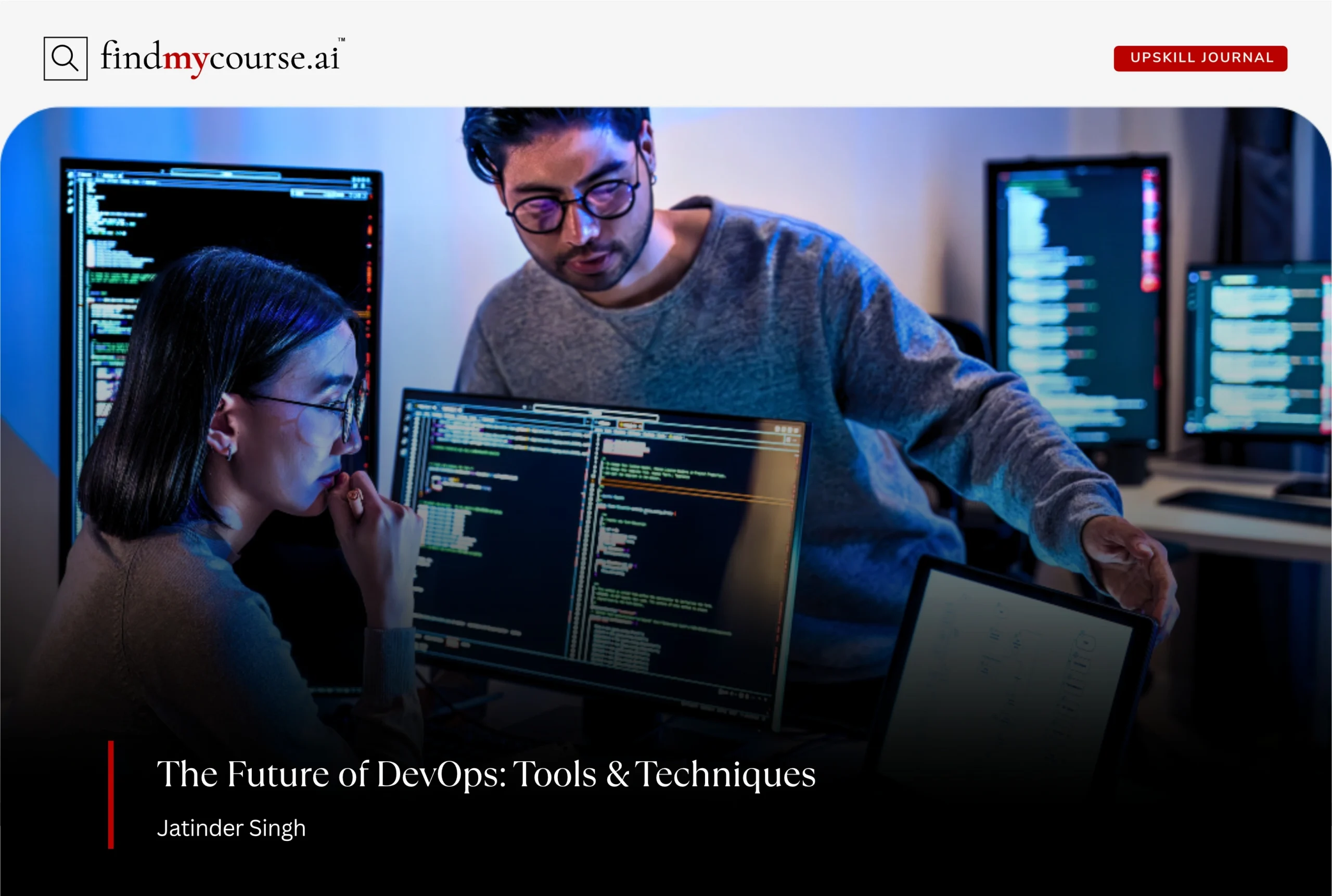DevOps is entering a new phase and what started as a way to speed up software delivery is now evolving into a smarter, more adaptive approach to building and running systems. As teams grow more distributed and infrastructures more complex, new DevOps trends are emerging to meet today’s demands—focusing on automation, collaboration, and resilience.
In this article, we’ll explore the key tools and techniques shaping the future of DevOps as well as how staying informed and continuously learning can help teams keep up with this rapid evolution.
What Is DevOps and What Does the Future Hold?
DevOps is a modern software development approach that brings together development and operations teams to collaborate more efficiently. It aims to shorten the software delivery cycle, increase deployment frequency, and ensure high-quality releases—all while reducing downtime and manual effort.
But the future of DevOps is evolving beyond just speed. As systems become more complex and user expectations rise, DevOps is expanding to include cloud scalability, security integration, automation, and intelligent observability. Moreover, modern teams must now manage distributed environments, secure applications from day one, and automate processes end to end.
These shifts are shaping the next generation of DevOps—one focused not just on delivery, but on resilience, trust, and developer empowerment. Organizations that embrace these changes and stay aligned with emerging DevOps trends will be better prepared to innovate, adapt, and succeed in the fast-paced digital world.
Top DevOps Tools Powering Modern Workflows
In a fast-moving DevOps environment, having the right tools is more than a convenience—it’s a necessity. Additionally, today’s DevOps trends emphasize speed, consistency, and collaboration across distributed teams. The tools listed below help reduce manual overhead, improve automation, and enable secure software delivery.
Infrastructure as Code (IaC)
Infrastructure as Code transforms infrastructure management into software development. Tools like Terraform and AWS CloudFormation allow teams to define servers, networks, and services as code—enabling automated, version-controlled, and repeatable deployments.
Moreover, this trend reflects a shift away from manual configurations and toward fully codified, declarative infrastructure. This makes it easier to manage cloud complexity and ensure environment consistency across teams.
CI/CD Platforms
Continuous Integration and Continuous Delivery (CI/CD) are foundational to DevOps. Tools like GitHub Actions, GitLab CI, CircleCI, and Jenkins automate the process of testing, building, and deploying code.
These platforms support the DevOps trend of shorter feedback loops—ensuring that code changes are tested early, deployed faster, and released with higher confidence. Modern pipelines also integrate security, compliance, and rollback mechanisms, reducing risk at scale.
Containers & Orchestration
Containers have revolutionized how applications are built and deployed. Docker allows developers to package software with all its dependencies, while Kubernetes orchestrates these containers across clusters, handling scaling, load balancing, and fault tolerance.
This toolset enables cloud-native architecture—supporting modular, portable, and resilient systems that work reliably across dev, staging, and production.
Observability & Monitoring
Modern DevOps teams can’t operate blindly. Tools like Grafana, Prometheus, Datadog, and OpenTelemetry provide deep visibility into system performance, logs, metrics, and traces.
The shift toward observability over traditional monitoring means teams can now detect issues proactively, reduce downtime, and understand system behavior in real time—critical for high-availability environments.
DevSecOps Integrations
Security can no longer be an afterthought. DevSecOps tools like Snyk, Aqua Security, and HashiCorp Vault integrate security checks directly into CI/CD pipelines—automating vulnerability scanning, secrets management, and policy enforcement.
This reflects the broader “shift-left” trend: catching risks early in development instead of later in production, making security both scalable and developer-friendly.
Internal Developer Platforms (IDPs)
A growing trend in mature DevOps organizations is the rise of Internal Developer Platforms. Tools like Port, and Humanitec enable teams to create self-service environments where developers can deploy, test, and monitor their code independently.
These platforms improve the developer experience (DevEx), reduce dependency on ops teams, and encourage faster, safer releases.
Modern DevOps Techniques to Watch
While tools provide the foundation, it’s the techniques and practices that define how effectively DevOps is implemented. The most successful teams don’t just adopt new technologies—they evolve their workflows to match the changing landscape of software delivery. These are the key DevOps techniques that are gaining traction and shaping the future of the DevOps trends:
GitOps
GitOps is a powerful technique where Git repositories act as the single source of truth for both application and infrastructure deployments. By using Git to manage configurations and trigger changes, teams gain version control, auditability, and easier rollback options.
This practice is particularly useful for Kubernetes and cloud-native environments, where managing complexity through code is critical. GitOps promotes safer, more transparent workflows.
Shift-Left Security
Traditional security checks often happened too late—after code was written or deployed. The shift-left approach moves security earlier into the development process, using tools that scan for vulnerabilities as developers write code.
This proactive technique helps catch issues before they escalate, reduces risk, and aligns security with speed. It’s a key component of DevSecOps, ensuring that teams don’t sacrifice safety for delivery speed.
AIOps and Intelligent Automation
As systems grow in scale and complexity, AI is stepping in to assist. AIOps (Artificial Intelligence for IT Operations) leverages machine learning to detect anomalies, analyze logs, predict outages, and recommend fixes—before problems escalate.
This trend supports more autonomous operations and reduces the burden on human teams, making it easier to manage large, distributed environments with less manual effort.
TestOps and Continuous Testing
Testing isn’t a phase—it’s a continuous process. TestOps is the integration of automated testing into every stage of the CI/CD pipeline. This ensures that quality remains high without slowing delivery.
So, by adopting practices like test-driven development (TDD) and automated regression testing, teams can identify bugs early, improve stability, and maintain speed.
Microservices & Serverless Architectures
Monolithic applications are giving way to microservices and serverless functions, which break software into smaller, loosely coupled components.
This architectural shift improves scalability, resilience, and deployment flexibility. Teams can release features independently, scale only what’s needed, and reduce cloud costs—aligning with the trend toward more modular, agile systems.
Developer Experience (DevEx)
A growing focus in modern DevOps is developer experience—ensuring that engineers have the tools, workflows, and support they need to do their best work.
This includes things like fast build times, intuitive APIs, clean documentation, and self-service environments. Teams are realizing that happy developers lead to better software, and DevEx is becoming a critical measure of DevOps success.
What’s Driving Today’s DevOps Trends?
DevOps isn’t evolving in a vacuum. It’s being shaped by real-world demands—faster development cycles, growing cloud complexity, remote collaboration, and ever-increasing security needs. These forces are pushing teams to rethink how they build, deploy, and maintain software.
- Remote and hybrid work models require flexible, cloud-based collaboration tools.
- Cloud-native scale demands automation, policy management, and dynamic infrastructure.
- Cybersecurity threats are increasing, pushing security earlier into the process.
- Business pressure to release faster, cheaper, and more reliably is intensifying.
Together, these drivers are shaping DevOps trends that’s more automated, secure, intelligent—and most importantly, human-centered.
How to Get Started with DevOps
To stay ahead in DevOps trends, build a solid foundation and grow steadily:
- Learn the Essentials: Start with Git, Docker, Kubernetes, and Terraform.
Try: Try: Intro to DevOps (edX), CI/CD (Coursera) - Automate Early: Begin with simple tasks—like tests or deployments—then expand automation across your workflow.
- Shift Security Left: Integrate security and testing in development to catch issues early and release safer code.
- Make Monitoring Routine: Use tools like Prometheus or Grafana to track system health continuously—not just during issues.
- Keep Learning: Follow DevOps blogs, join communities, and take short courses to stay updated.
Start small, stay curious, and improve steadily—DevOps is all about smart, continuous progress.
Final Thoughts
Now we’ve seen how DevOps continues to evolve—driven by new tools, techniques, and the growing need for smarter, more resilient systems. The trends shaping DevOps today aren’t just technical—they reflect a broader shift toward better collaboration, security, and developer experience.
For teams navigating this change, staying current isn’t always easy. But with the right support, it becomes a lot more manageable. If you’re looking for guidance along the way, our AI assistant is here to help you explore, learn, and move forward with confidence.


